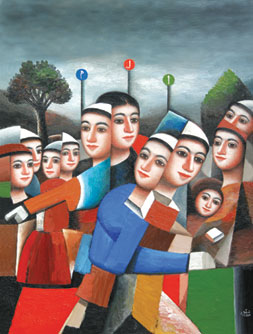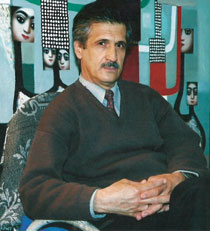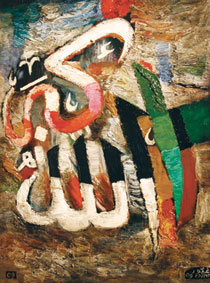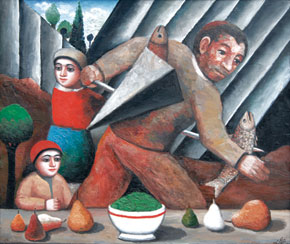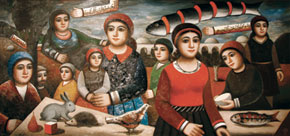Pages 90-94
by Sarah Oghuz
Gayyur Yunus engages with this age-old Azerbaijani art as a craftsman with his own style of painting. His works are an organic combination of the natural colours of his native land, the gentle dreams of its people and the vision of an ancient oriental culture which has survived the trials of the centuries. Ordinary everyday events are endowed with deep philosophical import. Daily cares and household chores are generalized and become madrigals painted about people, their hopes and their deeds. Gayyur Yunus’s painted madrigals - the artistry of the characters and the metaphorical completion of the environment in which they exist - are derived from the creativity of folklore. Nourished by the best traditions of the Gajar School of painting and learning from the monumental vision of wall paintings, Yunus has adopted a creative approach to these sources, expanding their technical and literary potential and preparing a new stage of easel painting in Azerbaijan. His decorative ornamental alliterations feed on a depth of perspective based on a perception of greatness created by the portrayal of two-dimensional forms, and his paintings, which drink the elixir of psychological depth, are a successful synthesis of the western and eastern approaches to art. More precisely, Yunus’s creativity is his way of explaining the conception of the genetically-rooted beauty of his environment, of the modern human being standing in the stream of complicated cultural currents. Gayyur Yunus’s aesthetic outlook is far removed from feelings of either deep tragedy or absolute happiness. To become engaged only with things of beauty or with the subject of painting, to glorify this beauty artfully, is not his ultimate aim either. The characters in his compositions are always welcomed by a will and desire emerging from the past, but directed towards the future. This psychological atmosphere, enriching the canvases in the course of time, gives an internal dynamism to these characters.
At one with nature and each other
Visually static, they have hidden in their depths the heat of spirituality and the true eastern expression of steady movement and existence compose the major atmosphere in Gayyur Yunus’ compositions. The characters in his compositions are not isolated from one another, they are not in conflict their environment, they are closely associated with each another and they live in harmony with nature. Since their creation, human beings have wished to see themselves in association with other living beings, they have not welcomed feelings of obscurity, the untrue feeling of infinity. This is why they have idealized animals and plants, and tried to endow them with spiritual qualities, they have tried to perceive things not as isolated beings, but in contact with other things, things within an environment. Ancient Azerbaijani tribes thought of oxen and wolves as their relatives; they imagined their world standing on a fish; they thought of death as a transition from one world into another world. This feeling of unity with the universe, with time, has brought comfort to people living before the greatness of nature, has given meaning to their deeds and dreams. The world of Gayyur Yunus’s characters is just such a vital, pantheistic world. These are common people who see a fish beside them, who create a shrine from a tree and have faith in it: “Rassam Ashraf Muradoglunun khatirasina” (In Memory of Ashraf Muradoglu), “Khoshbakhtlig aghaji” (The Tree of Happiness). Examples of love, making life possible in this mortal world: lovers, whose fate is to have their marriage sanctioned in heaven: “Adam va Havva” (Adam and Eve), “Nishan” (Engagement), “Kalla Gand” (Pressed Sugar), “Bulbul” (Nightingale) etc. Of course when we use the term “nature” in Yunus’s work we don’t mean nature in the open air conception. The open-air is foreign to his work. On the contrary, the artist always locates his character in an enclosed place. His characters, isolated from the chaos and dark colours of nature, are very familiar. Simply the unrelenting intimacy of his characters with each other ensures his superiority in the detail, his inner orchestra establishing the harmony of his compositions.
Humanity stares out
In his drawings, too, on which Gayyur Yunus worked with a colour plan, his painter’s mind dominates that of the sketcher. Crisp, emotional colours are added to whatever the drawing may express. Consequently his drawn canvases are regarded as a certain phase of the artist’s development of a painting. The elements of the compositions are worked in free, immediate lines, as if they are not lying on the paper, on the contrary, they have been torn from the heart of the white page and long to see the world. The dynamics of Gayyur Yunus’s drawings are neither centralising nor the opposite. His drawing is like a blast of energy. It breaks into thousands of small pieces, the elements of composition, and spreads across the page. The energy of these drawings is unexpected and creates excitement. The potential energy in pages worked this way seems to hold the surface of the composition under tension. This is often achieved in the form of oxen and birds as if they are in natural surroundings: “Mugaddas cheshma” (Holy spring), “Seyr” (Observation), “Chaghirish” (Summons) etc. There are canvases from which an example of humanity, or a certain period of humanity, stares out at you. At least a thousand years of our people’s history peeps out from the canvases of Gayyur Yunus.
by Sarah Oghuz
Gayyur Yunus engages with this age-old Azerbaijani art as a craftsman with his own style of painting. His works are an organic combination of the natural colours of his native land, the gentle dreams of its people and the vision of an ancient oriental culture which has survived the trials of the centuries. Ordinary everyday events are endowed with deep philosophical import. Daily cares and household chores are generalized and become madrigals painted about people, their hopes and their deeds. Gayyur Yunus’s painted madrigals - the artistry of the characters and the metaphorical completion of the environment in which they exist - are derived from the creativity of folklore. Nourished by the best traditions of the Gajar School of painting and learning from the monumental vision of wall paintings, Yunus has adopted a creative approach to these sources, expanding their technical and literary potential and preparing a new stage of easel painting in Azerbaijan. His decorative ornamental alliterations feed on a depth of perspective based on a perception of greatness created by the portrayal of two-dimensional forms, and his paintings, which drink the elixir of psychological depth, are a successful synthesis of the western and eastern approaches to art. More precisely, Yunus’s creativity is his way of explaining the conception of the genetically-rooted beauty of his environment, of the modern human being standing in the stream of complicated cultural currents. Gayyur Yunus’s aesthetic outlook is far removed from feelings of either deep tragedy or absolute happiness. To become engaged only with things of beauty or with the subject of painting, to glorify this beauty artfully, is not his ultimate aim either. The characters in his compositions are always welcomed by a will and desire emerging from the past, but directed towards the future. This psychological atmosphere, enriching the canvases in the course of time, gives an internal dynamism to these characters.
At one with nature and each other
Visually static, they have hidden in their depths the heat of spirituality and the true eastern expression of steady movement and existence compose the major atmosphere in Gayyur Yunus’ compositions. The characters in his compositions are not isolated from one another, they are not in conflict their environment, they are closely associated with each another and they live in harmony with nature. Since their creation, human beings have wished to see themselves in association with other living beings, they have not welcomed feelings of obscurity, the untrue feeling of infinity. This is why they have idealized animals and plants, and tried to endow them with spiritual qualities, they have tried to perceive things not as isolated beings, but in contact with other things, things within an environment. Ancient Azerbaijani tribes thought of oxen and wolves as their relatives; they imagined their world standing on a fish; they thought of death as a transition from one world into another world. This feeling of unity with the universe, with time, has brought comfort to people living before the greatness of nature, has given meaning to their deeds and dreams. The world of Gayyur Yunus’s characters is just such a vital, pantheistic world. These are common people who see a fish beside them, who create a shrine from a tree and have faith in it: “Rassam Ashraf Muradoglunun khatirasina” (In Memory of Ashraf Muradoglu), “Khoshbakhtlig aghaji” (The Tree of Happiness). Examples of love, making life possible in this mortal world: lovers, whose fate is to have their marriage sanctioned in heaven: “Adam va Havva” (Adam and Eve), “Nishan” (Engagement), “Kalla Gand” (Pressed Sugar), “Bulbul” (Nightingale) etc. Of course when we use the term “nature” in Yunus’s work we don’t mean nature in the open air conception. The open-air is foreign to his work. On the contrary, the artist always locates his character in an enclosed place. His characters, isolated from the chaos and dark colours of nature, are very familiar. Simply the unrelenting intimacy of his characters with each other ensures his superiority in the detail, his inner orchestra establishing the harmony of his compositions.
Humanity stares out
In his drawings, too, on which Gayyur Yunus worked with a colour plan, his painter’s mind dominates that of the sketcher. Crisp, emotional colours are added to whatever the drawing may express. Consequently his drawn canvases are regarded as a certain phase of the artist’s development of a painting. The elements of the compositions are worked in free, immediate lines, as if they are not lying on the paper, on the contrary, they have been torn from the heart of the white page and long to see the world. The dynamics of Gayyur Yunus’s drawings are neither centralising nor the opposite. His drawing is like a blast of energy. It breaks into thousands of small pieces, the elements of composition, and spreads across the page. The energy of these drawings is unexpected and creates excitement. The potential energy in pages worked this way seems to hold the surface of the composition under tension. This is often achieved in the form of oxen and birds as if they are in natural surroundings: “Mugaddas cheshma” (Holy spring), “Seyr” (Observation), “Chaghirish” (Summons) etc. There are canvases from which an example of humanity, or a certain period of humanity, stares out at you. At least a thousand years of our people’s history peeps out from the canvases of Gayyur Yunus.
